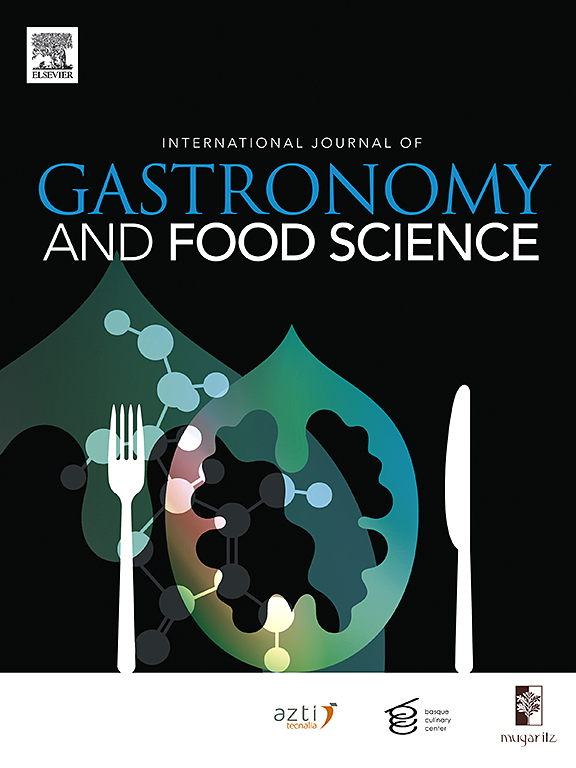Unveiling Port wine vinegar: A comprehensive study on chemical and sensory profile
IF 3.2
2区 农林科学
Q2 FOOD SCIENCE & TECHNOLOGY
International Journal of Gastronomy and Food Science
Pub Date : 2025-03-08
DOI:10.1016/j.ijgfs.2025.101160
引用次数: 0
Abstract
Once merely a culinary staple, vinegar has evolved into a multifaceted ingredient valued for its flavor enhancement and potential health benefits. Port wine vinegar from the Iberian Peninsula stands out for its rich nutrient profile and unique sensory characteristics. This study provides a comprehensive descriptive analysis of the chemical and sensory properties of Port wine vinegar alongside other types of wine vinegar, including white wine, red wine, and balsamic vinegar. The analysis highlights the distinctive characteristics of each vinegar type based on their chemical composition and sensory profiles. Chemical analyses encompassed pH levels, acetic acid concentrations, ethanol content, total phenolic content, antioxidant activity, colorimetric parameters, and phenolic composition. Sensory evaluations were conducted to discern distinctive flavor profiles. Port wine vinegar's reddish-brown hue and nuanced flavor are vital features described in this study, attributed to its aging process in oak barrels. Chemical analyses described the relatively low pH, moderate acetic acid concentration, and notable phenolic content of Port wine vinegar, including epigallocatechin and catechin gallate. Aging was associated with higher polyphenol concentrations across the samples. These phenolic compounds, known for their antioxidant properties, contribute to the potential health benefits of vinegar consumption.
揭示葡萄酒醋:化学和感官特征的综合研究
醋曾经仅仅是一种烹饪主食,现在已经发展成为一种多方面的成分,因为它能增强风味,并对健康有潜在的好处。来自伊比利亚半岛的葡萄酒醋以其丰富的营养成分和独特的感官特征而脱颖而出。本研究对波特酒醋以及其他类型的葡萄酒醋(包括白葡萄酒、红葡萄酒和香醋)的化学和感官特性进行了全面的描述性分析。分析强调了基于化学成分和感官特征的每种醋的独特特征。化学分析包括pH值、乙酸浓度、乙醇含量、总酚含量、抗氧化活性、比色参数和酚成分。感官评估进行辨别独特的风味概况。波特酒醋的红褐色色调和微妙的味道是本研究中描述的重要特征,归因于它在橡木桶中的陈酿过程。化学分析表明,波特酒醋的pH值相对较低,醋酸浓度适中,酚类物质含量显著,包括表没食子儿茶素和儿茶素没食子酸酯。老化与样品中较高的多酚浓度有关。这些酚类化合物,以其抗氧化特性而闻名,有助于醋的潜在健康益处。
本文章由计算机程序翻译,如有差异,请以英文原文为准。
求助全文
约1分钟内获得全文
求助全文
来源期刊

International Journal of Gastronomy and Food Science
Social Sciences-Cultural Studies
CiteScore
5.30
自引率
10.50%
发文量
170
审稿时长
45 days
期刊介绍:
International Journal of Gastronomy and Food Science is a peer-reviewed journal that explicitly focuses on the interface of food science and gastronomy. Articles focusing only on food science will not be considered. This journal equally encourages both scientists and chefs to publish original scientific papers, review articles and original culinary works. We seek articles with clear evidence of this interaction. From a scientific perspective, this publication aims to become the home for research from the whole community of food science and gastronomy.
IJGFS explores all aspects related to the growing field of the interaction of gastronomy and food science, in areas such as food chemistry, food technology and culinary techniques, food microbiology, genetics, sensory science, neuroscience, psychology, culinary concepts, culinary trends, and gastronomic experience (all the elements that contribute to the appreciation and enjoyment of the meal. Also relevant is research on science-based educational programs in gastronomy, anthropology, gastronomic history and food sociology. All these areas of knowledge are crucial to gastronomy, as they contribute to a better understanding of this broad term and its practical implications for science and society.
 求助内容:
求助内容: 应助结果提醒方式:
应助结果提醒方式:


